Rockets for Dad--and one for London, too

This post is for my dad. When I was a kid, I was in 4-H. I learned all kinds of stuff in 4-H. Some of those things, like public speaking and basic photography, are central to the stuff I do now. Others, like horticulture and raising chickens, are on hold until we get to someplace with a yard (and tolerant neighbors). But those are all things I did through 4-H. They're not the reason I was in 4-H.
I was in 4-H for rockets.
I got my first rocket, an Estes Harpoon, when I was nine, the same year I got my first pocket knife. At the time Dad was running Wedel Oil Company in Hillsdale, Oklahoma, and the Wedel boys spent many an enjoyable afternoon listening to the old-timers who would come into the filling station to loaf. Dad had a couch and a couple of chairs out, and these old guys would sit around and tell stories forever. Some of them had been in World War II. One guy talked about being in Borneo and how he killed cobras by picking them up by the tail and cracking them like a whip to break their necks. I have always been grateful for those times. I feel like I got in on a little slice of American history that is all but gone, and by that I mean both the guys themselves, and the fact that they would come down to the station just to loaf. The next time you're in a small town and you see a bunch of old farts sitting around talking, grab a table nearby and just listen. Trust me.
But I digress. The actual gas station building had been built around the same time that man discovered fire. Dad has a compulsive need to improve buildings, and he took one quarter of the station and built walls and shelves and turned it into a multipurpose room. It had a door that I can't ever remember seeing closed, and a big open window onto the rest of the station, so you weren't really isolated in there. But it was our space, not customer space, and it was nice to have someplace to keep our stuff. Over the years that room served as an office, a playroom, and--crucially--a rocket factory.
The model rockets I knew as a kid had cardboard body tubes, balsa fins, and plastic nose cones, and they went together with care, patience, and generous helpings of Elmer's glue. When I started making them I was pretty short on the first two ingredients, and Dad helped. Heck, he probably did most of the work, but however we divvied up the labor, it felt pretty equitable to a 9-year-old. Harpoon had missile stylings and decals and would fly to about 500 feet. Dad built a launch system out of wire, alligator clips, and a doorbell buzzer. We would drive the pickup just a few hundred feet from the house to a grassy patch of unused land, hook up the launcher to the pickup battery, and launch rockets. It was the best thing ever.
Other rockets followed. My second was an Estes Magician, which flew to over 1000 feet on a D motor. Dad and I launched it in a pasture on a calm day. It may have been calm on the ground, but there was some serious wind blowing at 1000 feet, and after the rocket popped its parachute we chased it for more than a quarter mile. I did a science fair project on model rockets, comparing the performance of rockets with square, unsanded fins to those with fins that had been sanded into an airfoil shape and sealed with wood sealant. The sanded-and-sealed rockets flew twice as high as the rough ones. I tracked them with a homemade alititude tracker made from a protractor.
In 4-H, the rockets not only had to fly, they had to look spiffy, too. They were to be entered in the county fair and judged on appearance. So we spent a lot of time building them and putting on paint and decals. My cousin Michael introduced me to another school of rocketry, in which you built the thing in the morning, launched it in the afternoon whether the glue was dry or not, and painted it when and if it came back. I don't know that we ever permanently lost a rocket. Michael's Scout disappeared on us, but Michael found it floating in Uncle Robert's farm pond a while later. The next summer we taped up its ejection port, launched it at night, and watched it explode. It was awesome.
Hands down, our favorite rocket was the Estes Geo Sat LV. It was a scale model of a satellite launcher, loosely based on the Titan family, with a clear plastic payload section that contained a little satellite. It looked rad, and when it took off.... The Geo Sat was more than two feet tall, which was not enormous but still much bigger than any other rocket in Wedel experience. We were used to the Harpoon and Magician and Wizard, which just sorta vanished off the launch pad when you pressed the ignition button. Geo Sat lifted off slowly and majestically, with lots of fire and smoke and noise. It felt like launching a real rocket.
Incidentally, all of these rockets are still in existence, propped against an usused wall in the upstairs bedroom that was mine and then my brother Todd's. I imagine that the rubber band shock cords and plastic parachutes could stand to be replaced after 15-20 years of inactivity, but the rockets are flyable. In fact, maybe we'll dust them off this Christmas and let them go.
All of this came back to me about a month ago, when another grad student in my department sent out an announcement about a rocket launch at the park. I had blown my Christmas money on a few kits but I hadn't built any of them, so I dug them out of the closet and got to work on my first rockets in about 15 years. I was guided by the engineering spirit of Dad, who would help me get fins and decals on straight so the rockets would look great and fly straight, and that of Michael, who just wanted to put something in the air as fast as possible. So I built rockets derived from both philosophies.
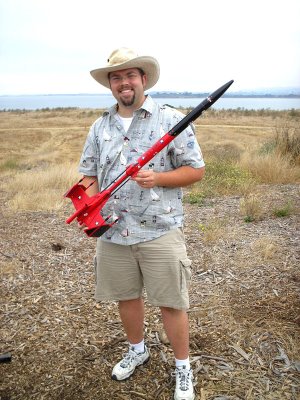
For Dad: the Thunderhawk, a space fighter of my own design, painstaking thought out, constructed, painted, and detailed over the course of a month. The body tubes and nose cone came from Estes kits, but almost everything else I whipped up from scratch. She flies loud, low, and slow on D motors. No quarter-mile hikes with this one! She came down within a few yards of the pad every time.

For Michael: the Turd Burd, another MJW original, constructed in two days out of paper towel and toilet paper tubes, cardboard from a cereal box, duct tape, glue, with a plastic pod from a drugstore toy machine serving as a nose cone. Also slow and fairly low on C motors, with a straight boost and an easy recovery every time. She comes down on two crepe paper streamers. I figured if that wasn't enough to keep her from getting damaged, who cares? But she's as rugged as she looks.
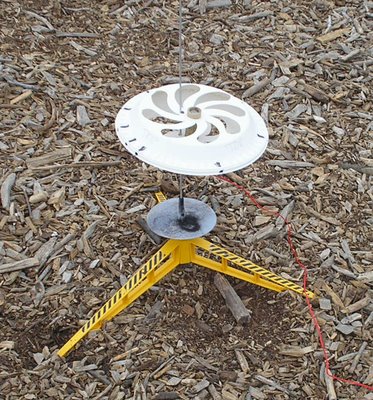
I also had a couple of paper rockets and a flying saucer made from Hefty Serve 'N Store plastic plates, the kind that snap together at the edges. I had to put in a picture of the thing on the launch pad so you'd believe me. There was an aerospace engineer at the launch and she was equally flabbergasted by my willingness to fly such an unlikely thing and by its exceptionally straight and stable boosts. All of my rockets flew straight, especially the ugly ones, and they all came back in one piece (except for the Turd Burd, which was designed to come back in two pieces). More importantly, they made me happy.
Dad, you'd love 'em all. The Thunderhawk and the Turd Burd both fly like the Geo Sat used to, slow and noisy with lots of smoke. But for the slowest, noisiest, smokiest liftoffs ever, the flying saucer has to be seen to be believed. Witness:
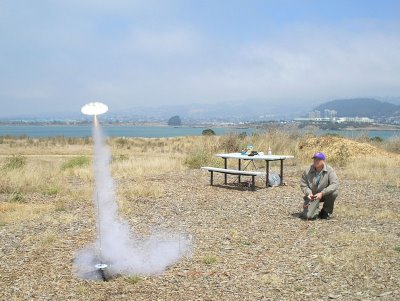
London came along and had a great time, thanks to the diligent baby-chasing of our friends Alan and Sophie, Joel, and Jann and Gene. My head was literally in the clouds and I only got one good photo of the little man, but as baby/rocket photos go, it's a doozy.
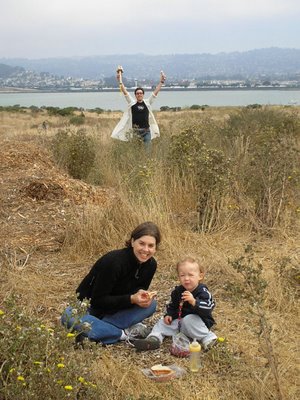
Being plagued with some unfathomable excess of kindness, Jann volunteered to give London his lunch. Meanwhile, Joel was prepping the Turd Burd for its second flight, Gene was doing his time in the recovery team, chasing rockets that drifted into the bushes on their way down, and I was running around taking pictures. After Joel launched the Turd Burd, Gene picked it up and was running it back to the launch area when he passed right behind Jann and London. I yelled for him to stop running and hold up the rocket, and there you go.
Gene and I made out pretty well that day. There were two awards given, for highest or longest flight and for best design. Gene's Bandit had flown to the limit of vision on an A or B motor. He launched it on a C (twice the power of a B, four times that of an A) and we never saw it again. Those with sharper eyes than mine swear that it flew into a cloud. He was not visibly put out by the loss, and why not? Sending a little thing that you built yourself into a cloud is pretty cool. And that flight netted him the prize for highest or longest flight, since for all any of us knew, his rocket was still up there somewhere. (I'm not just being flowery here--at those alititudes a rocket could drift for hours on its parachute. Remember the Magician!). I got the prize for best design, not for any one rocket but for the whole fleet. Gene's prize was an insulating water bottle jacket in the shape of a rocket, and mine was a little soft-sided cooler, also rocket-shaped.
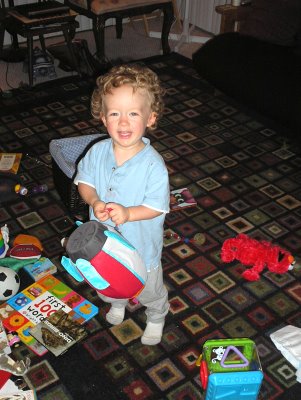
It is an especially useful prize. For one thing, we have a little cooler like this already that we use to carry London's bottles of milk and juice, but it's ugly. Also, London likes to play with anything that has a zipper he can work, especially soft-sided bottle coolers. Finally, I'd been wondering about some kind of rocket toy for London, but hadn't come up with anything. So I got a prize, the family got a useful device, and London got a toy.
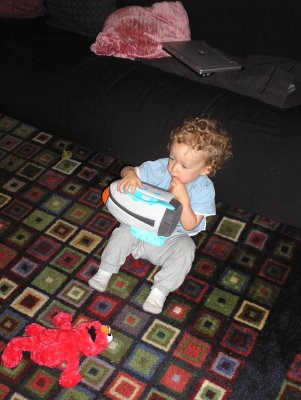
If you're curious, the rest of the photos from the launch are available here.
Dad, thanks for all the help with rockets over the years. The next time you're out here, I'm going to start repaying my debt. We're going to launch some rockets.
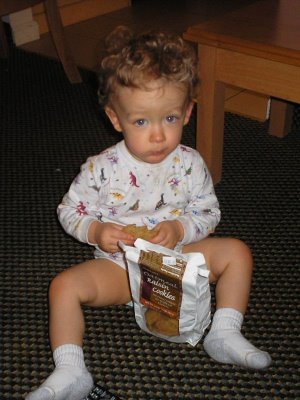

0 Comments:
Post a Comment
<< Home